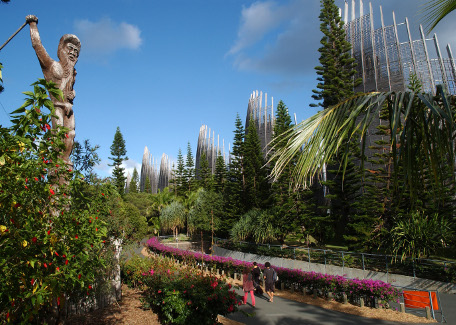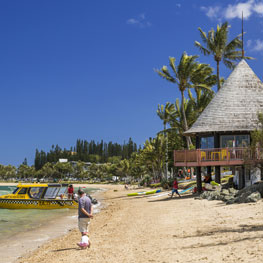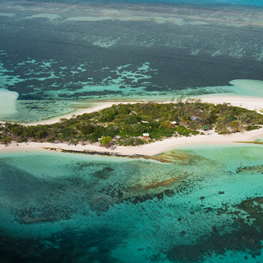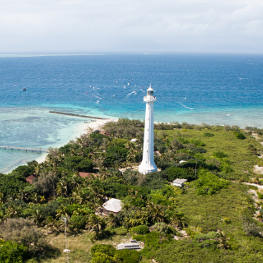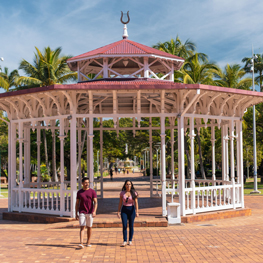Do you wish to be introduced to Kanak culture? Then visit the iconic Tjibaou Cultural Centre in Nouméa, whose idyllic setting combines an art centre, a museum, performance spaces, a library and a landscaped park, its cultural breadth delighting both adults and children. Welcome to the world of Kanak society. This masterpiece, in the heart of a preserved natural site, is minutes away from the city and offers permanent and temporary exhibitions, as well as various shows: its visit is a must.
Included in the Matignon agreements of 1988, The Tjibaou cultural center was inaugurated in May 1998. The project was given to the world-renowned Italian architect Renzo Piano (who also designed the Centre Pompidou in Paris, for example, with Richard Rogers) The architectural ensemble is a modern and monumental version of the island's vernacular architecture.
The center is named after the Kanak political leader Jean-Marie Tjibaou (1936-1989), and is located on a site of 8 hectares, by the sea, between the Magenta and Tina bays.
Every year, the cultural center welcomes over 100,000 visitors, half of which are occasional visitors coming to discover the site and the exhibitions on display. The second half is made of students, spectators of the different shows and participants in the seminars, conferences and congresses.
An architectural masterpiece
Voir plus-
![Architecture in harmony with Kanak culture]()
Architecture in harmony with Kanak culture
Past the entrance, you can admire the architecture of the centre, designed by Renzo Piano and characterized by a subtle blend of contemporary design and references to Kanak culture.
Promoting Kanak culture, this public institution is managed by the Kanak Culture Development Agency (ADCK). It is a museum, a multimedia library, a congress center, an auditorium, a research and creation center, as well as a botanical garden!
The “Kanak path” notably crosses the park, and invites the visitor to discover symbolic native essences and plants, retracing the 5 stages constituting the myth of the first man: Téâ Kanaké.
-
Ten ribbed and slender structures evoke traditional Kanak huts
The heart of the center is a 7,000 m² building consisting mostly of ten ribbed and slender structures evoking Kanak traditional huts. Made of both steel and Iroko wood, their height varies between 20 and 28 meters, and their surfaces from 55 to 140 m². The ten huts are next to a flat, lower building with an alley leading to the each hut and to the different rooms.
-
![Kanak art under the spotlight]()
Kanak art under the spotlight
A journey into the heart of Kanak art and heritage awaits you: Several exhibitions are organized, reflecting the richness of tribal art, with carved rooftop spears, everyday objects and intricately carved ritual sculptures, as well as reflecting the diversity of contemporary Kanak and Oceanian art.
The Bwenadoo hut, for example, houses Kanak heritage exhibitions, with objects lent by international museums (including the Quai Branly in Paris). The large Jinu hut displays art from the Pacific such as monumental sculptures from Papua New Guinea, the Solomon Islands, Vanuatu, New Zealand or New Caledonia. Finally, the Bérétara and Kavitara rooms are dedicated to exhibitions of contemporary art from local artists or belonging to the Kanak and Oceanian Contemporary Art Fund (FACKO) managed by the ADCK. -
![Concert at Tjibaou Cultural Center]()
Eclectic events
The cultural programme includes a range of concerts, shows, dances, festivals, local markets. A wide choice is offered throughout the year, showcasing local productions, as well as international ones. The beauty of the place brings a touch of magic to these events.
Besides the permanent and temporary exhibitions, the center constantly hosts artistic residencies in a dedicated structure.
-
![Follow the Kanak path]()
Follow the Kanak path
Outside, the Kanak path winds along the mangroves: This initiation journey introduces you to the myth of the creation of the first man. This exciting walk is enlivened by the performance of the dance group We Ce Ca. You will understand the close relationship between nature and culture in Kanak society, as well as the importance it gives to plants.


